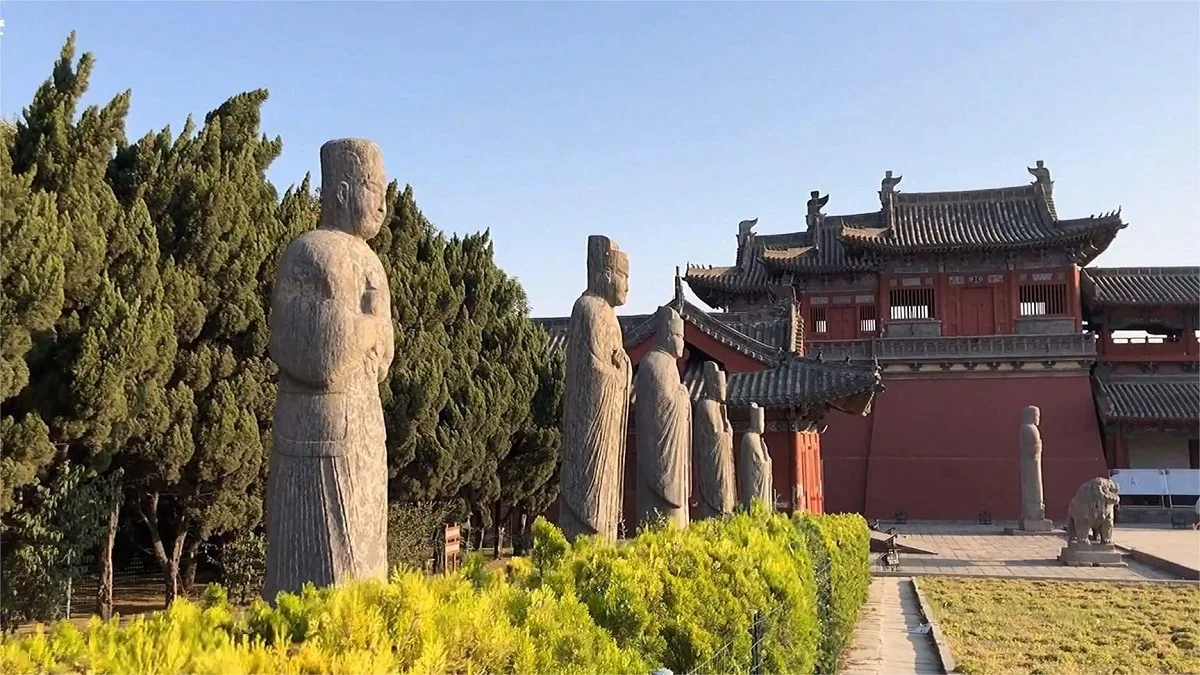The Imperial Mausoleums of the Song Dynasty (北宋皇陵) comprise over 300 tombs, covering an area of approximately 156 square kilometers. Established in 963 AD, these mausoleums were constructed over a period of more than 160 years. They serve as the final resting places for seven emperors of the Northern Song Dynasty, as well as Zhao Hongyin (the father of Zhao Kuangyin), collectively referred to as the “Seven Emperors and Eight Mausoleums.” Additionally, nearly a thousand tombs belonging to empresses, imperial princes, princesses, grandchildren, and meritorious generals surround the imperial tombs, forming a vast and magnificent royal necropolis, often likened to an open-air museum of art.
The Imperial Mausoleums of the Song Dynasty pioneered several innovative approaches to tomb construction, reflecting the highly structured hierarchy of the imperial court. This unique burial complex embodies a rigorous and distinctive royal funeral culture, making it invaluable for the study of the administrative systems and stone carving art of the Song Dynasty. Notably, it is the only burial site in China where the tombs face south, a feature that sets it apart from other imperial mausoleums.
Table of Contents
- Basic Information
- Location and Transportation
- Highlights of the Imperial Mausoluems
- Vlog about the Imperial Mausoleums
- Other Attractions in Gongyi
Basic Information
| Estimated Length of Tour | 2 hours |
| Ticket Price | Free |
| Opening Hours | 8.00 – 18.00 |
| Telephone Number | 0086-0371-64356170 |
Location and Transportation
Located in Gongyi City, Zhengzhou, Henan Province, the Imperial Mausoleums of the Song Dynasty lie between the northern foot of Mount Song and the Luo River, encompassing hills and plains. To reach the mausoleum area within Gongyi City, visitors can take bus routes 3, 6, or 1 and disembark at Yongzhao Mausoleum Park.
Highlights of the Imperial Mausoluems
Yong’an Mausoleum
Serving as the primary mausoleum of the Song Dynasty, Yong’an Mausoleum is located in Changfeng Village, Xicun Town, Gongyi City. It is the burial site of Emperor Taizu Zhao Hongyin and Empress Dowager Zhao Hongyin. The mausoleum is characterized by its impressive size, with a length of 520 meters from north to south and a width of 230 meters from east to west. The tomb mound is shaped like an overturned bucket and is adorned with four small stone carvings. Notably, it also houses the tombs of four empresses and 121 accompanying relatives.
Yongchang Mausoleum
Situated in Longwa, 15 kilometers north of Xicun Town in Gongyi City, Yongchang Mausoleum is the second imperial tomb of the Song Dynasty. Spanning 546 meters from north to south and 230 meters from east to west, it features a tomb platform shaped like an overturned bucket. The mausoleum is renowned for its collection of 47 stone carvings, which are representative of early Song Dynasty stone sculptures. Among the buried individuals here are Empress Xiaozhang of Emperor Taizu and Empress Zhaohuai of Emperor Zhenzong.
Yongxi Mausoleum
Located northeast of Hutuohu Village in Xicun Town, approximately 7.5 kilometers south of Gongyi City, Yongxi Mausoleum is the tomb of Emperor Taizong Zhao Guangyi. It is characterized by its grandeur, with historical records describing the imperial hall as 100 feet deep and 80 feet wide, and the spiritual platform as 250 feet square. The mausoleum boasts 62 stone carvings, notable for their large size and rich content. It also houses the tombs of Empress Yuan De, Empress Mingde, and Empress Zhaomu.
Yongding Mausoleum
The burial site of Emperor Zhenzong Zhao Heng, Yongding Mausoleum is situated north of Caizhuang Village in Zhitian Town, approximately 10 kilometers south of Gongyi City. Spanning 1100 meters from north to south and 720 meters from east to west, the mausoleum’s upper palace, divine gate, and four corner pavilions are well-preserved. With 60 stone carvings, it houses the tombs of Empress Zhangyi and Empress Zhangxian.
Yongzhao Mausoleum
Serving as the burial site of Emperor Renzong Zhao Zhen, Yongzhao Mausoleum is located between Xinhua Road and Jianshe Road in Gongyi City. The mausoleum stretches 980 meters from north to south and 260 meters from east to west, with a three-tiered divine platform. Noteworthy features include the reconstruction of the magpie platform, breast platform, four divine gates, four corner pavilions, and the mausoleum platform itself. Empress Cisheng Guangxian Cao is buried in the northwest of Yongzhao Mausoleum.
Yonghou Mausoleum
Situated in the western part of Gongyi City, specifically within the cultivated land of Li Gou, Waigou, and Ershili Village of Xiaoyi and Dufu Streets, Yonghou Mausoleum is the tomb of Emperor Yingzong Zhao Shu. Spanning 750 meters from north to south and 300 meters from east to west, the mausoleum boasts well-preserved architectural remnants and 56 stone carvings depicting smaller-sized figures. Empress Xuanyi Shenglie Gao is interred here.
Yongyu Mausoleum
The burial site of Emperor Shenzong Zhao Xu, Yongyu Mausoleum features a “reversed bucket” shape with a slightly square base, measuring around 60 meters on each side and approximately 18 meters in height. While the original two-tiered platform with brick and stone on the lower level and dense pine and cypress trees on the upper level no longer exists, 17 stone sculptures remain. Additionally, Empress Zhaohuai Pan and other consorts are buried in this mausoleum area.
Yongtai Mausoleum
Located approximately one mile southwest of Baliang Village in Zhitian Town, Gongyi City, Yongtai Mausoleum is the tomb of Emperor Zhezong Zhao Xu. The mausoleum complex consists of upper and lower palaces and the burial site of Empress Zhaohui Liu. Notably, the upper palace is positioned about 134 meters north of the breast platform and spans around 240 meters on each side. The mausoleum area also features a towering divine wall measuring 4-5 meters in height and 56 stone carvings portraying imposing warriors.
Yongxian Mausoleum
Following the death of Emperor Qin Zong, his tomb was initially located between Gongyi and Luoyang. Eventually, it was relocated to the Northern Song Imperial Mausoleum area in Gongyi, Henan Province, and became known as Yongxian Mausoleum.





